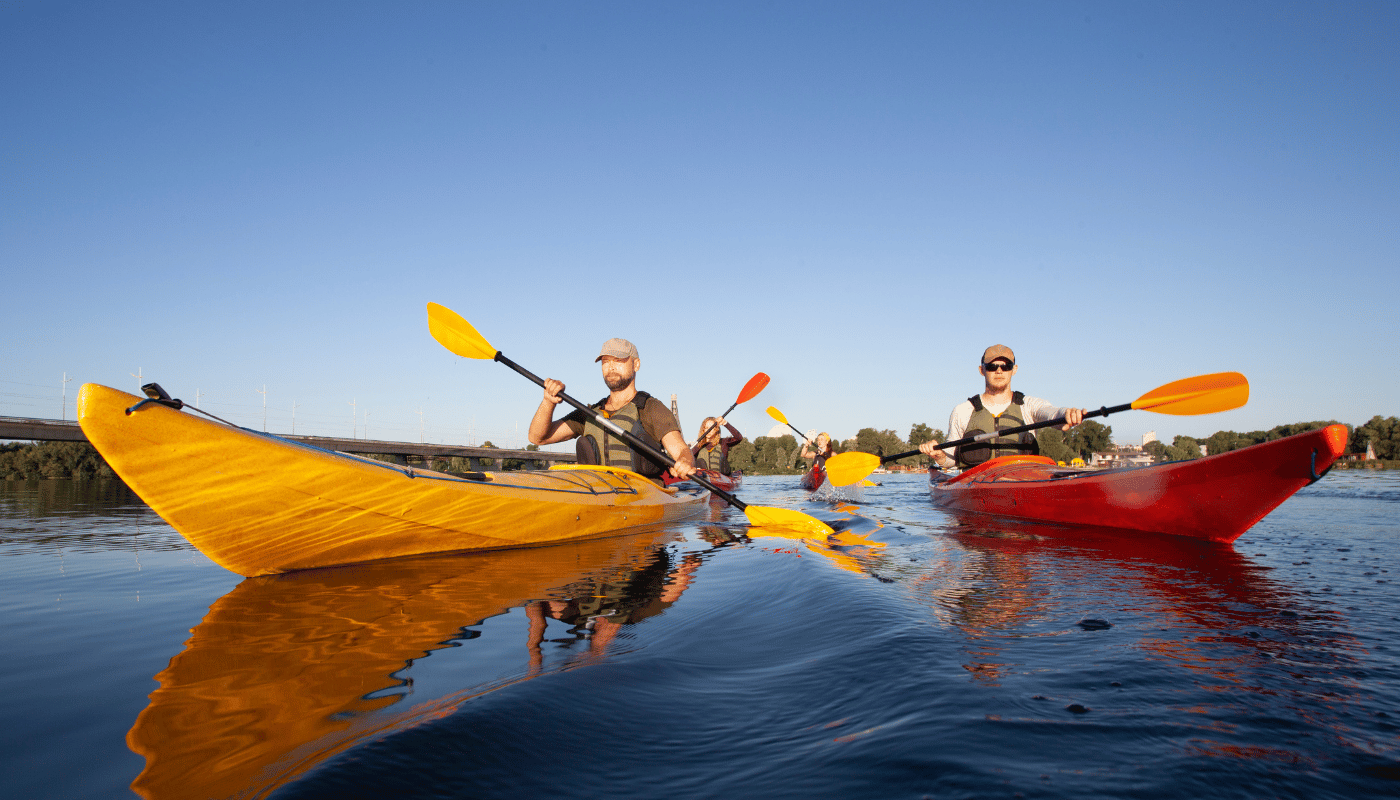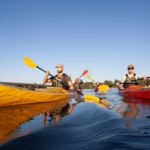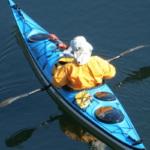Kayaking is not just an enjoyable water sport, but it also provides an excellent full-body workout. As interest in fitness activities continues to grow, many people wonder about the impact of kayaking on weight loss, particularly targeting belly fat. This has led to the question: “does kayaking burn belly fat?” The short answer is yes—kayaking can help burn calories and reduce fat, including stubborn belly fat. However, to understand how it works, it’s important to recognize the factors involved, such as calorie expenditure, muscle engagement, and the overall effectiveness of kayaking as a fitness activity.
Kayaking is a dynamic activity that involves intense core engagement, along with the activation of various muscle groups in the arms, back, and legs. This full-body engagement makes it an effective calorie-burning exercise. While kayaking itself is not a magic solution for belly fat, it does contribute to overall fat loss, which over time can help reduce the appearance of belly fat when combined with a balanced diet and regular exercise.
To plan your activity, familiarize yourself with when the kayaking season starts. Read there for more information on the best time to start kayaking and make the most of your outdoor adventures. In addition to its benefits for fat burning, kayaking also has cardiovascular benefits. It increases your heart rate and helps improve endurance, which is vital for long-term weight management. Whether you’re paddling on calm waters or navigating more challenging rapids, kayaking provides a great way to stay active and work toward your fitness goals.
How Does Kayaking Burn Belly Fat?
Kayaking is an excellent physical activity that helps burn calories and build muscle, both of which contribute to fat loss. The secret lies in the way it engages multiple muscle groups and increases your overall caloric expenditure.
When you paddle, your body works as a cohesive unit, with the core playing a central role in stabilizing your kayak. Every stroke requires your abdominal muscles to twist and contract, which directly engages the core and helps strengthen these muscles. While kayaking does not exclusively target belly fat, it promotes overall fat burning, including the abdominal area, by raising your heart rate and building lean muscle mass.
In addition to the core, kayaking activates the arms, shoulders, back, and even the legs. This full-body workout contributes to a higher calorie burn compared to exercises that only target specific muscles. The consistent motion and resistance from the water further enhance this effect, making kayaking an effective exercise for burning fat over time.
How Kayaking Helps Burn Belly Fat
- Core Engagement: The rotational movement of paddling strengthens and tones abdominal muscles.
- Full-Body Workout: Activates upper and lower body muscles for increased calorie burn.
- Cardiovascular Exercise: Boosts heart rate, aiding in overall fat loss.
- Resistance Training: The water’s resistance increases muscle engagement and calorie expenditure.
After the list, it’s important to note that belly fat reduction requires consistency and a balanced approach. While kayaking is effective, combining it with other exercises and maintaining a healthy diet is key to achieving visible results. Kayaking provides a unique mix of cardio and strength training, making it one of the most enjoyable ways to work toward fat loss.
The Science Behind Fat Burning with Kayaking
The process of burning belly fat is rooted in the science of metabolism and calorie expenditure. To lose fat, including belly fat, your body must burn more calories than it consumes, creating a caloric deficit. Kayaking is an excellent way to contribute to this deficit because it combines aerobic exercise with resistance training, both of which are known to enhance fat-burning.
When you engage in an activity like kayaking, your body primarily uses stored glycogen for energy during the initial stages. As you continue, it gradually shifts to burning fat for fuel, especially during prolonged sessions. This is why longer kayaking trips can be particularly effective for fat loss. Additionally, the physical effort required to paddle raises your heart rate and stimulates your metabolism, which helps you burn calories both during and after the activity.
Another important factor in belly fat reduction is the role of stress and cortisol levels. High cortisol levels, often caused by stress, can lead to fat accumulation around the abdominal area. Kayaking, with its calming effect and outdoor setting, helps reduce stress and lower cortisol levels. This indirect benefit makes it an even more appealing option for those looking to reduce belly fat.
Finally, building muscle through activities like kayaking also plays a role in fat burning. Muscle tissue burns more calories at rest compared to fat tissue, meaning that increasing your muscle mass can boost your overall metabolism. The combination of aerobic and anaerobic effort involved in kayaking makes it a well-rounded exercise for achieving fat loss.
While kayaking is not a quick fix for belly fat, the science supports its effectiveness as part of a balanced fitness plan. By combining kayaking with a healthy diet and other forms of exercise, you can achieve long-term results and improve your overall health.
Calories Burned in Kayaking: A Comparison with Other Exercises
When it comes to weight loss, burning calories is key to reducing fat, including belly fat. Kayaking is a great way to burn calories, but how does it compare to other common exercises in terms of energy expenditure?
On average, kayaking burns between 400 to 500 calories per hour, depending on the intensity and the individual’s body weight. This makes it a moderate to high-calorie burning activity. Compared to other popular workouts, kayaking holds its ground as an efficient calorie-burning exercise. For example, cycling and running are often considered top calorie burners, but kayaking can match or exceed these activities, especially when you add resistance or speed to your paddling.
Running, on average, burns around 600-800 calories per hour, depending on pace and intensity. Cycling, at a moderate pace, typically burns about 400-700 calories per hour. While these activities are more land-based, kayaking offers unique benefits, such as engaging the upper body and providing a more low-impact workout for the joints. This makes kayaking a great option for those looking to burn calories without the high-impact strain of running or cycling.
Calories Burned in Different Exercises
| Exercise Type | Calories Burned per Hour (Average) | Intensity Level |
| Kayaking | 400-500 | Moderate-High |
| Running | 600-800 | High |
| Cycling | 400-700 | Moderate-High |
| Swimming | 400-700 | Moderate-High |
While kayaking may not always burn as many calories as running or cycling, it provides a full-body workout that is gentle on the joints. This makes it a viable option for people of various fitness levels, including those who may have joint pain or injuries that prevent them from participating in high-impact activities. The continuous movement of paddling, especially in choppy waters or while navigating currents, increases the intensity of the exercise and boosts calorie burn.
Overall, kayaking can burn significant calories, which contributes to weight loss, including the reduction of belly fat, when done consistently and combined with a healthy diet.
Benefits of Kayaking for Overall Fitness
Kayaking isn’t just an enjoyable water sport; it also offers a range of health benefits that make it an excellent addition to any fitness routine. While it is effective for burning calories and reducing belly fat, kayaking also enhances overall physical fitness and well-being.
First, kayaking is a full-body workout. Unlike exercises that isolate specific muscle groups, kayaking requires the activation of multiple muscle groups simultaneously. From the core to the arms, shoulders, and legs, every stroke engages muscles, contributing to muscle toning and strength-building. This not only helps with fat loss but also improves muscle endurance and joint flexibility.
Kayaking is also an excellent cardiovascular workout. It elevates the heart rate, helping improve cardiovascular health and increase aerobic capacity. Consistent kayaking sessions can improve stamina, increase lung capacity, and lower the risk of cardiovascular diseases.
Additionally, kayaking is a low-impact exercise, making it suitable for people with joint issues or those who prefer a gentler workout. The buoyancy of the water reduces stress on the joints, making kayaking easier on the body than high-impact activities like running or weightlifting. This makes kayaking an accessible option for individuals of all fitness levels.
The mental benefits of kayaking should not be overlooked either. Spending time on the water can have a calming effect, reduce stress, and improve mental clarity. Being surrounded by nature also provides opportunities for relaxation and mindfulness, which contribute to overall well-being.
Tips for Maximizing Fat Loss While Kayaking
If you’re specifically targeting belly fat and wondering, “does kayaking burn belly fat?”, it’s essential to approach kayaking as part of a well-rounded fitness plan. While kayaking does help in burning calories and reducing fat, you can maximize its fat-burning potential by following a few simple tips.
Firstly, maintaining proper form while kayaking is crucial. Engaging your core throughout each stroke helps target the abdominal muscles. This continuous engagement will ensure that you’re not just paddling but actively working your midsection, which can enhance fat loss over time. Incorporating interval training is another effective strategy. By alternating between fast-paced and moderate paddling, you can elevate your heart rate and keep it elevated for longer, increasing calorie burn and fat loss.
Effective Tips for Maximizing Fat Loss
- Focus on Proper Form: Keep your core engaged during each stroke.
- Incorporate Interval Training: Alternate between high and moderate-intensity paddling.
- Paddle on Open Water: Increase intensity by navigating waves or stronger currents.
- Track Your Progress: Set goals to stay motivated and monitor your calorie burn.
Another tip is to paddle in open water rather than calm, flat lakes. Paddling on rougher waters will challenge your balance and increase the intensity of the workout, leading to a higher calorie burn. Additionally, setting goals and tracking your progress can help you stay motivated. Consistent kayaking, combined with a balanced diet, will result in noticeable fat loss, including in the belly area.
Derivation
In conclusion, does kayaking burn belly fat? Yes, kayaking can be an effective way to burn calories, build muscle, and ultimately reduce body fat, including belly fat. While kayaking is not a spot-reduction exercise, it does contribute to overall fat loss, especially when practiced regularly as part of a balanced fitness routine.
Kayaking offers the advantage of a full-body workout, engaging muscles in the core, upper body, and lower body, while also providing cardiovascular benefits. By burning calories through paddling, you create a calorie deficit, which is the key to fat loss. Over time, this can help reduce belly fat and improve your overall body composition.
To maximize the benefits of kayaking, focus on maintaining proper form, incorporating interval training, and paddling in open water for a more intense workout. And remember, while kayaking can help burn belly fat, pairing it with a healthy diet and other forms of exercise will provide the best results for long-term fat loss.





